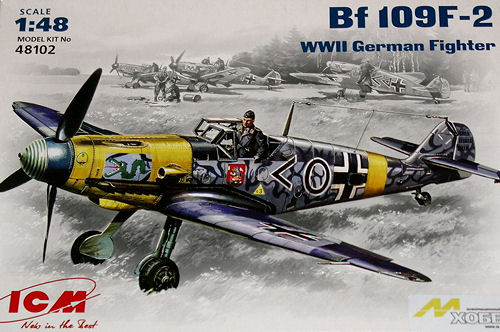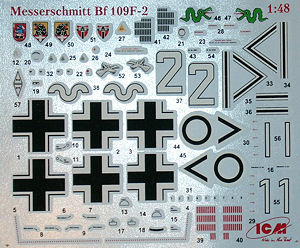
| KIT: | ICM 1/48 Bf-109F-2 |
| KIT #: | 48102 |
| PRICE: | @$16.98 |
| DECALS: | Four options |
| REVIEWER: | Marjan Urekar |
| NOTES: |

| HISTORY |
Friedrich (not Fritz, nor Franz) was the major redesign of Bf 109, with new sleek looks, improved aerodynamics, new DB 601 engine giving much more speed, nose mounted cannon firing thru spinner (as intended since E version) and no elevator struts. It was stopgap solution till G version comes, and it gave nasty surprise to Spitfire pilots, outperforming most of the machines flying at the time. It was best 109 version as stated by many German pilots, later G versions introduced heavy equipment and firepower making it too sluggish. Although ready in 1940, F wasn’t introduced till early 1941, mainly due new engine being late in production and RLM opinion that Emil was good enough.
Bf 109F-2 was introduced in March 1941, soon after F-1, first production version, reached units, still with old DB 601N engine, and new rapid firing MG151/15 15mm auto-cannon instead old MG/FF in the nose. Some pilots, like Galland, considered this weapon arrangement to light, especially for inexperienced fliers, so later F-4 got heavier MG151/20, still not heavy enough.
Friedrich was the principal fighter at the start of Russian campaign and many top aces started their scores with this fine plane.
| THE KIT |
 For those following ICM story, this
is the infamous, long awaited kit. Several years ago, ICM shelled its over
engineered Spitfire marred with deep sinkholes on every major part, over
intricate details. There was also Tamiya ’inspired’ Mustang series, so some
considered ICM ’bad guy’ and loudly advocated against it. Soon as Bf 109 series
was announced, the company went under. It went under Alanger, kits went into
various sales, when suddenly no one had objections against cheap Tamiya
knock-off.
For those following ICM story, this
is the infamous, long awaited kit. Several years ago, ICM shelled its over
engineered Spitfire marred with deep sinkholes on every major part, over
intricate details. There was also Tamiya ’inspired’ Mustang series, so some
considered ICM ’bad guy’ and loudly advocated against it. Soon as Bf 109 series
was announced, the company went under. It went under Alanger, kits went into
various sales, when suddenly no one had objections against cheap Tamiya
knock-off.
After new ICM management took over, some nice kits appeared in 1/72, and finally the 109.
 Box is standard flimsy ICM type, but
rather small, similar to 1/72 kits. There are 3 mid-grey sprues and one clear
with 99 parts in total. Plastic is much better then in old kits, not that soft
but with slightly pebbly surface. Panel lines are engraved, looking more like
Hobbycraft than Hasegawa, only shallower.
Box is standard flimsy ICM type, but
rather small, similar to 1/72 kits. There are 3 mid-grey sprues and one clear
with 99 parts in total. Plastic is much better then in old kits, not that soft
but with slightly pebbly surface. Panel lines are engraved, looking more like
Hobbycraft than Hasegawa, only shallower.
As matter of fact, the whole kit has that HC feel to it. No locating pins (short-run?).
So if it’s ICM, how bad sink holes are? Well, there are almost none, it seems like got their act together. There is one shallow one below cockpit, both fuselage halves have faint sink line along bottom part near the edge, maybe good layer of paint will cover it, or you’ll deal with it anyway as it’s just a mm from joint line. No ejection pin holes in critical places. Too much flash for new mould kit.
As before, a complete engine is given (not too impressive detailed though) hence a multi part cowling and nose.
No other fiddly panel inserts are used, so construction should be easier.
Parts breakdown, additional parts and empty spaces on sprues suggest many more versions, Fs and early Gs. You get regular prop and broader VDM type, but they look too pointy and slightly out of shape.
There are original shallow and later deeper oil cooler, only one, smaller, supercharger intake, extra set of exhausts and tropical filter. Most of the extra parts are marked not to be used.
Cockpit looks decent but too sparse for modern standards, floor with some detail, seat bucket, stick, rudder pedals, dash and some flat molded-on sidewall details, far from busy look original had, and the dash has scribed instrument faces without dials and no decal is given. Canopy is 3-piece, quite nice and clear.
Armored windscreen for F-4 is included, but it was retrofitted on some earlier machines too. Armored headrest is also of F-4 type, for earlier types you need to cut off circular top section.
Spinner needs opening cannon hole, and doesn’t have round enough profile, but just slightly. Cowling MG openings are rather faint and lack definition, but set of nice MG17s is given.
Fabric surfaces are given as rib detail with rough underneath, again like HC.
Wings have separate flaps and slats, but tips also, suggesting different variants, as bottom part could be made different for G versions. And there is major blunder – they used the wrong wing with angular wheel well openings as used on E and G versions, F had circular openings. As this part includes walls to make boxed-in wheel wells (upper wing has some inner detail molded), it makes job of making the right opening more complicated. Only very early F-1s had those squared openings in anticipation of cover that never came. (Your editor would like to point out that one could often find late F-4 variants with angular wheel wells. At least according to many references that I've read in the last few years. Ed).
Wheels are of correct type, but with slightly rough details.
Tails section has external stiffeners used on F-1 and early F-2, as later planes had internal structure reinforced to prevent it from losing the tail. Consult your references, most will need that detail removed.
Panel lines and access openings are on correct positions for this version, spine looks too flat without prominent fall to the tail section, but I haven’t pulled drawings on it.
So what can you build from it? Add supercharger intake and loose stiffeners and you get preproduction F-0. Early F-1 comes out of the box, all later versions need circular wheel openings like late F-1 and early F-2. For later F-2 remove external stiffeners. Find 87 octane fuel triangle decal for F-3. Source larger G-variant supercharger intake from some other kit, use deeper oil cooler and broader prop for F-2/Z, tropical filter add-on for -1 and -2 /Trop. Add larger supercharger intake, armored panel to windscreen and unmodified headrest for F-4, -4/Z and -4/Trop similar to those before. Add ETC 250 bomb rack for /B versions. F-5 is similar to F-4 with deleted cannon, F-6 is real recce bird with camera aperture below and behind pilot. With some minor rescribing, deeper oil cooler and larger prop you can make G-2 and even early G-4 without wing bumps.
Decal sheet is of newer ICM, far better than used to be, still matt and with much decal film around larger decals.
 Four options with full stencils are
given, all F-2 in standard RLM 74/75/76 scheme:
Four options with full stencils are
given, all F-2 in standard RLM 74/75/76 scheme:
Black <O+, I/JG3, Ukraine 1941 – with yellow nose, wing tips and fuselage band, serpent and emblem insignia of the unit, small spiral on spinner, large score on tail, and wave patterns on fuselage sides instead mottling
White 1+|, 7/JG2, France, summer 1941 – yellow rudder and bottom cowling, 1/3 black on white spinner, small flag on antenna mast and large mottling
White 2+~, 7/JG54, Leningrad, autumn 1941 – yellow nose and rudder, flying shoe and unit insignia, impressive score on tail, black spinner with small white portion, and heavy mottling on fuselage.
Black <|+-, JG54, Baltic, summer 1941 – Yellow wing tips and broad fuselage band, unusual black/white spinner, and cross-hatched type of mottling on fuselage and tail.
| CONCLUSIONS |
Long awaited kit, still a mixed bag. Some earlier faults like sink marks, iffy plastic and too many separate panels are eliminated. Some shape issues, few prominent accuracy omissions. Won’t replace Hasegawa but is a choice for budget modeler in the East being 2-3 times cheaper, while it gets to the West, price will get higher. Not recommended to beginners due to large parts count and some fiddly bits.
October 2006
If you would like your product reviewed fairly and quickly by a site that has over 325,000 visitors a month, please contact me or see other details in the Note to Contributors.